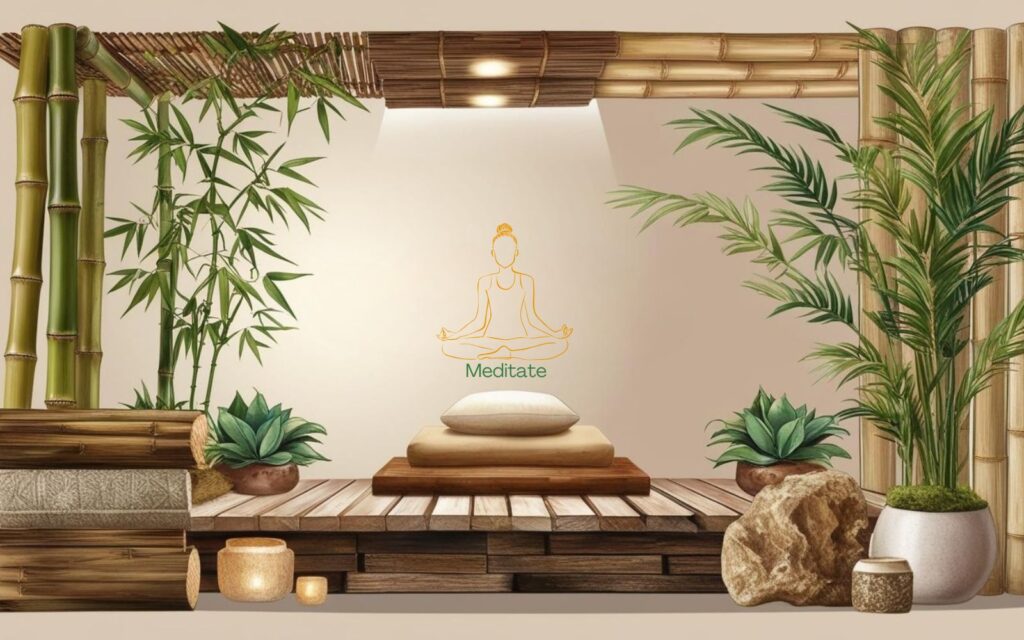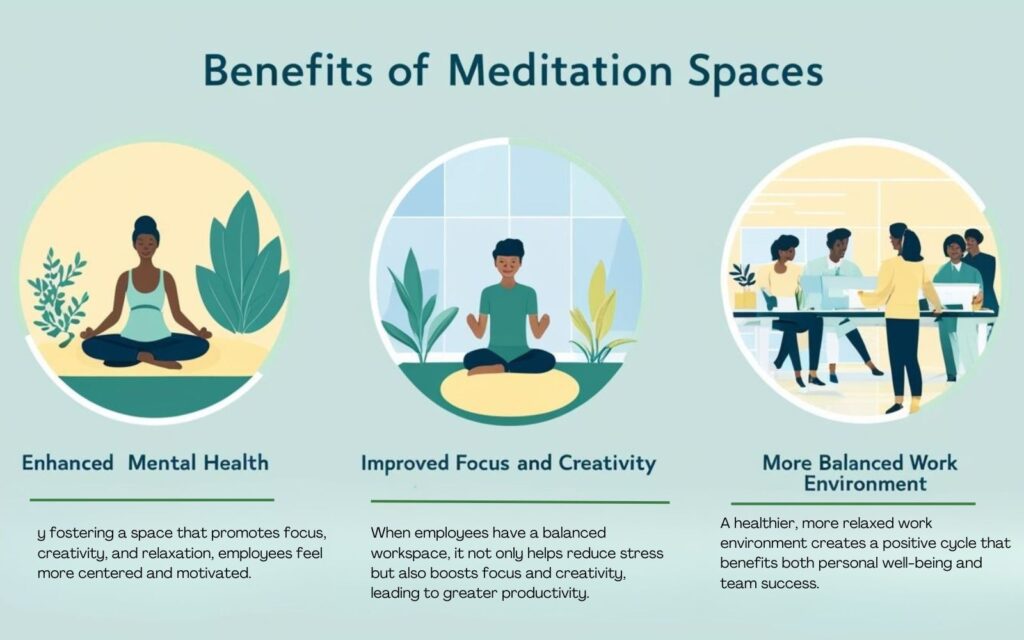Meditation Spaces in Sustainable Offices: A Path to Employee Well-Being and Productivity

Do you ever feel overwhelmed at work? Long hours, constant notifications, and a fast-paced office environment can be detrimental to mental health.
That’s why more companies are focusing on creating meditation spaces in sustainable offices – providing a quiet room where employees can recharge.
These meditative spaces offer a perfect escape from workplace stress. They’re designed with natural light, soft lighting, and eco-friendly materials to enhance employee well-being while promoting sustainability.
From meditation rooms to outdoor spaces, these areas cater to different needs and support mindfulness, emotional intelligence, and overall wellness.
In this article, we’ll explore the business benefits of these spaces, how they fit into workplace design leader trends, and why the growing awareness around mindfulness is shaping the future of work.
Key Takeaways
- Meditation spaces in sustainable offices help reduce stress and enhance employee well-being.
- Quiet spaces improve focus, creativity, and productivity.
- Sustainable office spaces incorporate eco-friendly materials and natural light.
- Employers can create meditation spaces on a budget with simple design changes.
- More companies are investing in meditative spaces as part of a holistic work environment.
Why Meditation Spaces Matter in the Workplace

1. Reducing Stress and Enhancing Productivity
Workplace stress affects employees’ ability to focus, make decisions, and stay motivated.
A quiet space allows workers to take mindful breaks, increasing productivity and efficiency.
2. Improving Employee Well-Being
A workplace that values well-being shows a strong message of care.
Meditation spaces improve mental health, reduce anxiety, and create a more supportive office environment.
3. Encouraging Mindful Breaks
Instead of checking emails or social media, employees can use quiet rooms for relaxation and mindfulness practice.
Short breaks improve creativity and help workers return with a refreshed mindset.
4. Strengthening Workplace Culture
Companies investing in meditation, prayer, and lactation rooms foster an inclusive, wellness-focused culture.
This attracts talent and enhances retention.
Sustainable Elements of Meditation Spaces

1. Eco-Friendly Materials
- Bamboo flooring – A renewable, sustainable option.
- Reclaimed wood furniture – Reduces waste and adds warmth.
- Organic cushions and rugs – Chemical-free for better air quality.
2. Natural Light and Ventilation
- Skylights and large windows reduce the need for artificial lighting.
- Fresh air circulation creates a healthier space.
3. Biophilic Design
- Indoor plants like peace lilies and snake plants improve air quality.
- Living walls act as natural air purifiers.
- Water features provide a calming background sound.
4. Soft Lighting and Acoustics
- LED lights mimic natural light while being energy-efficient.
- Cork panels and recycled fabric reduce noise for a peaceful atmosphere.
5. Multi-Use Meditation Spaces
- Meditation rooms can double as prayer rooms or lactation rooms.
- Flexible seating allows for different meditation styles.
How to Create Meditation Spaces in Sustainable Offices

1. Select a Quiet Location
- Find a private space with minimal distractions.
- If indoor space is limited, consider outdoor spaces like rooftop gardens.
2. Incorporate Natural Elements
- Use wood, stone, and neutral tones for a calming effect.
- Add greenery to enhance relaxation.
3. Provide Comfortable Seating
- We offer floor cushions, ergonomic chairs, and hammocks, among others.
4. Use Technology for Guided Meditation
- Provide meditation apps, QR codes, and audio-guided sessions.
- Install a soft lighting system that adjusts to time and mood.
5. Encourage Employee Engagement
- Organize mindfulness workshops.
- Support different meditation practices to cater to diverse needs.
Business Benefits of Meditation Spaces

For Employees
- Enhances mental health and well-being.
- Improves focus, creativity, and relaxation.
- Creates a more balanced work environment.
For Employers
- Boosts productivity and engagement.
- Reduces workplace stress and absenteeism.
- Enhances the company’s reputation as a workplace design leader.
Summary
The growing awareness around meditation spaces in sustainable offices is shaping the future of work.
By integrating quiet, private, and outdoor spaces into the office environment, companies strongly communicate that they prioritize employee well-being.
From meditation rooms with natural light to multi-purpose office spaces, these wellness-focused designs reduce stress and support productivity, mindfulness, and creativity.
As more companies invest in sustainable work environments, employee and employer benefits become undeniable.
It’s time for workplaces to embrace meditative spaces as a key part of modern workplace design.
Frequently Asked Questions
What Are the Key Elements of Meditation Spaces in Sustainable Offices?
To create a peaceful atmosphere, these spaces incorporate natural light, soft lighting, eco-friendly materials, biophilic design, and quiet areas.
How Can Small Offices Include Meditation Spaces?
A quiet room with plants, cushions, and low lighting can be a meditation space.
Employers can start small and expand based on feedback.
Are Meditation Spaces Expensive to Implement?
Not necessarily. Simple additions like indoor plants, noise reduction panels, and soft lighting can create an adequate relaxation space on a budget.
Do Meditation Spaces Improve Productivity?
Yes! Employees who use meditative spaces for short breaks return with better focus, creativity, and motivation, leading to increased productivity.
What Other Wellness Spaces Should Companies Consider?
Workplaces can offer prayer rooms, lactation rooms, mindfulness zones, and meditation rooms to support diverse needs.





